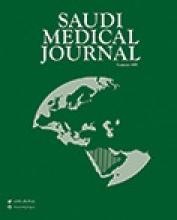Abstract
OBJECTIVE: To determine the predictive value of commonly used clinical and laboratory factors for mortality in patients with pneumonia in the Arab world.
METHODS: We retrospectively analyze the data collected from all inpatients over the age of 16 years with a diagnosis of pneumonia in Tawam Hospital, Al-Ain, United Arab Emirates between the years 1997 and 2002. Patients were grouped into those who survived and those who died in the hospital. Clinical and laboratory factors on admission were used to predict outcome using simple, and multiple logistic regression analyses.
RESULTS: Among the 236 patients admitted, 122 were females (age 56.9 ± 23 years), and 114 males (age 58.5 ± 23 years). The 30-day mortality rate was 10%. The most common comorbid risk factors were diabetes mellitus in 23.7% and chronic obstructive pulmonary disease in 19.5%. Of the 236 patients, 145 had sputum culture on admission. Simple logistic regression analysis showed increasing age, presence of comorbidity, low systolic blood pressure, confused mental status, low serum albumin, high serum creatinine, raised blood urea nitrogen and raised partial pressure of carbon dioxide at the time of admission were associated with higher mortality. On the Stepwise-multilogistic regression analysis, the most significant factors influencing mortality were: older age, altered mental status, low systolic blood pressure, low serum albumin and raised serum creatinine. Using a scoring system developed in the presence or absence of these risk factors, a score of >=100 predicted high risk for mortality.
CONCLUSION: The in-hospital mortality rate for pneumonia was 10%. Older age, altered mental status, low systolic blood pressure, low serum albumin concentration and raised serum creatinine at admission were predictive of poor outcome in this cohort of patients.
- Copyright: © Saudi Medical Journal
This is an open-access article distributed under the terms of the Creative Commons Attribution-Noncommercial-Share Alike 3.0 Unported, which permits unrestricted use, distribution, and reproduction in any medium, provided the original work is properly cited.






